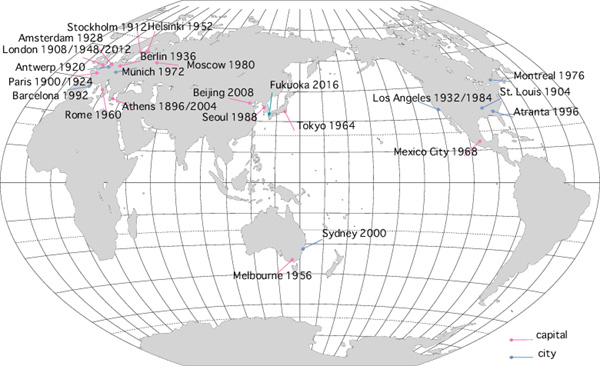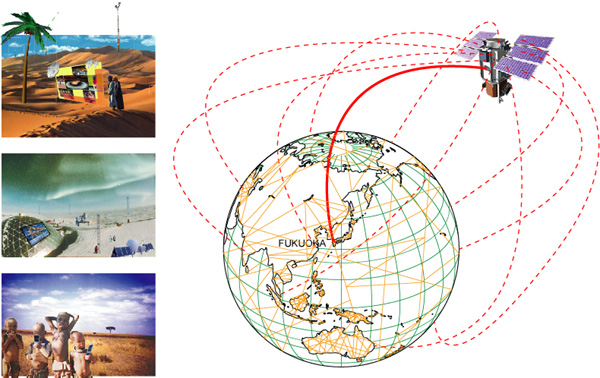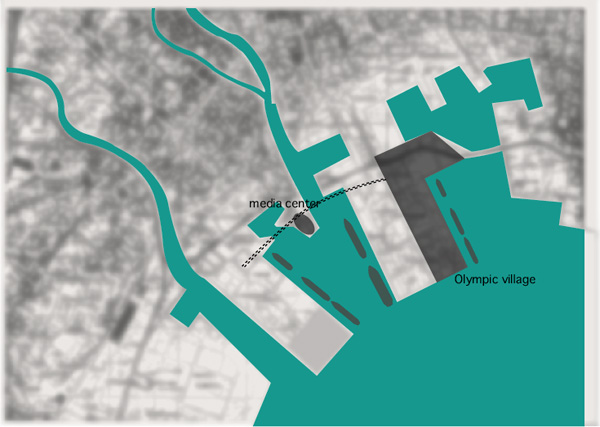|
JAPANESE
|
|---|
| Bringing the Olympics to Hakata Bay |

|
|
Shifting from the 20th century model of Olympic Games venues to a 21st century model- Instead of a capital city Olympics focused on boosting national prestige, 2016 should be a regional Olympics focused on the athletes who assemble from around the world.
|
|
Arata Isozaki Executive Producer's Office March 3, 2006
|
|
1. 2016 -- An opportunity to recapture the original Olympic spirit 2. Kyushu -- the eastern corner of the "East Asian Common House" 3. Hakata Bay -- the whole of the bay area becomes the main Olympic venue 4. Sports facilities featuring variability and supplementary functionality -- traditional hallmarks of Japanese architecture 5. Satellite and broadband make the world a single village with a direct link to the Olympics 6. The sea and ships produce a village for athletes, officials and media representatives 7. Feasts to welcome visitors -- Festivity and hospitality from the whole of Fukuoka and Kyushu 8. The Olympic legacy -- a major convention city on the Hakata-Fukuoka axis facing the sea |
| 1. 2016 -- An opportunity to recapture the original Olympic spirit |

|
More than 80% of cities that have hosted the Olympic Games in modern times have been national capitals or similar national cities. Baron Pierre de Coubertin, who conceived the concept for the modern Olympics, wanted athletes from all around the globe to assemble in a corner of the world to compete with one another while challenging their individual physical limits. The 1936 Berlin Olympic Games turned this concept on its head, as Hitler took the opportunity to use the Olympics to promote his racial ideology, creating a venue that boosted national prestige. This became the model for subsequent Olympic Games held throughout the 20th century. Individual countries have backed their capital cities or national cities in a bid to boost national prestige to mark recovery from the Second World War, the debut of a new state or a particular theme. As a consequence, countries put national flags on the backs of the athletes who carried their passports and made the Games a competition over the number of medals gained. We can expect the cities currently preparing for the next two Olympic Games, Beijing and London, to continue in this tradition and deliver Olympics of this 20th Century prototype. Now, however, is the time to think about what sort of Olympic model will befit the 21st century. The first step is to recapture the original spirit of the Olympics before it was altered by Hitler. The reason why a small center like Fukuoka, Kyushu in a corner of the world is bidding to host athletes from all around the globe is because we know that the 21st century deserves an Olympic Games that transcends the framework of state or race. Hakata Bay will deliver the first true 21st century Olympics. |
| 2. Kyushu -- the eastern corner of the "East Asian Common House" |

|
In historical terms, a single cultural sphere has grown centered on the East China Sea. Even though its coastline is now divided into separate countries and regions, it has seen a flourishing of political, economic and cultural exchanges, including tourism and special events. In geopolitical terms, the region that has built these kinds of relationships is called the "East Asian Common House." With the East China Sea in the center, all of the important ports lie along its coast. Situated at its eastern corner, the island of Kyushu in the Japanese archipelago is a natural part of the East Asian Common House and a keen participant in economic and cultural exchanges within the region. Fully aware of its position as a member of the East Asian Common House, Kyushu would like to host the 2016 Olympic Games in cooperation with the other coastal cities. A new type of ship that will serve as a resort for tourist events is scheduled to be brought into service ten years from now on the sea bordered by the members of the Common House. It will even be possible to hold the various zone qualifying rounds in different coastal cities, and continue training onboard these ships as they sail to a terminal in Hakata Bay. The geopolitical advantages of Hakata Bay as a location within the East Asian Common House can be utilized by adopting a plan that takes its cue from the sea. |
| 3. Hakata Bay -- the whole of the bay area becomes the main Olympic venue |

|
The whole of Hakata Bay will become the main Olympic venue, with all major facilities situated on the Hakata coast. They will include the main athletics stadium and other facilities for 25 principal sports, an athletes' village, accommodation for media representatives and an operations center for the Olympic Headquarters. There are many islands dotted around Hakata Bay, including Shikanoshima where the famous gold seal was discovered and Nokonoshima, which is known for its rich traditions. As such, it is an inland sea formed on an exquisite scale, and when sailing into the bay from the open sea the waves calm, bringing a wonderful sense of relief. The city stretches east to west on its southern coast and expressways traverse the area while dividing the land from the sea. The main cluster of Olympic facilities will be contained within an area of two kilometers square next to these expressways and will face the sea. In other words, they will be situated at the junction linking the sea and the land. From the sea side access will be by ship only, while from the land side access will be by mass transport or on foot. In this way, a highly efficient security system can be maintained at the venues despite the location being in physical contact with the city. It will be possible to survey all three clusters of venues from the sea. Water lies in the foreground, the verdant tops of hills and gentle slopes in the background, while the air is fresh and unpolluted. There is absolutely no way to achieve such a clean natural environment in a metropolis. The way that the venue facilities are located in and make the most of this natural environment is one of the distinctive features of this Olympics. We are planning to create an ideal and unpressured environment where athletes can demonstrate their well-honed skills. The key point of this plan is the way that the whole of Hakata Bay becomes the main Olympic venue. |
|
4. Sports facilities featuring variability and supplementary functionality -- traditional hallmarks of Japanese architecture |

|
Future Olympic facilities require the introduction of fresh innovations and must not be constrained by existing fixed concepts. Many Olympic facilities in capital cities that were supported by state governments are grandiose structures akin to monuments. Many facilities were as good as destroyed after being used for only a few weeks to host the Olympic Games. In future, we need to find ways to ensure the sustainability of facilities constructed. If Olympic facilities are to continue to be used after the Games, consideration must be given to conversion to allow different sports and rearrangement to allow different kinds of events. Existing architectural techniques have resulted in fixed stadiums and spectator seating with the sole option being that of tearing them down. Japanese architectural traditions have a different approach, finding ingenious ways of rearranging spaces for different purposes by means of replacing partitions and bringing in different tools. Today, techniques like these are being created that have the potential to be applied to the architecture of the facilities used for the Olympics. Large-scale spectator seating can be moved and changed in size to correspond to the scale or nature of an event (variability), while the track surface can be completely removed and replaced with a different surface (supplementary functionality). Ideas like these originating from traditional Japanese methods will be incorporated into design. Variability will be incorporated into newly-constructed facilities and supplementary functionality will be added to pre-existing facilities. The eventual result of innovations like these will be Olympic venues that are totally different from anything seen in the past. |
|
5. Satellite and broadband make the world a single village with a direct link to the Olympics |

|
The number of media representatives covering the Olympics is many times the number of athletes who compete. At most hundreds of thousands of spectators can experience and savor the Olympics in person, but there is a global audience of billions watching the events on their screens. This is why today the positioning of cameras takes precedence over the views of spectators. This in turn alters the style of sports facilities. Sports grounds will probably be configured like television studios so that they can catch on camera the finest details of athletes' facial expressions. When this happens athletes take on starring roles as if in a movie. Just as satellites made it possible to receive live broadcasts worldwide, broadband enables massive amounts of complex information to be transmitted around the world. The combination of these two systems will give the global audience new ways of savoring and experiencing the events from what feels like close proximity. In order to meet the demands of the media to communicate instantaneously with the rest of the world, communications networks will cover the entire venue, and there will be a skillfully designed media operations center. Media organizations from all over the world send reporters to the Olympic Games, turning the Olympics into a drama played out on an enormous global stage. In addition to providing camera positions and movements, interviewing areas, and seats for reporters that enable easy movement, at the media operations center, we will provide sets for broadcasters that bring in the sights, sounds, and above all the beautiful natural environment of the host city, set against the ultimate backdrop of Hakata Bay. |
|
6. The sea and ships produce a village for athletes, officials and media representatives |

|
Apart from spectators, tens of thousands of people -- athletes, officials, media representatives, organizers and VIPs from around the world -- assemble at the Olympic Games. After a stay of several weeks they return to their homelands. An instant city appears in an extremely short time only to disappear like a mirage. This is what happens at an Olympic Games. Everyone must be able to follow his or her own optimum daily schedules for this period of several weeks. Athletes must maintain their perfect physical condition. The demanding task of providing the circumstances to achieve this is assigned to the host city. We will take full advantage of Hakata Bay by situating living quarters on the sea and on ships. The Olympic village, which must be protected by a foolproof security system and allow everyone to live as comfortably as required, will be located on what was once the sea -- on a pier and on a large site that functioned as the yard behind the pier. In addition, the huge complement of media representatives will travel over the sea of the East Asian Common House and stay in large cruise ships and event-oriented ships docked alongside the Olympic site. These ships will also be equipped with information centers. Once the Olympic Games are over, the Olympic village will be remodeled into comfortable housing located conveniently near the city center. Meanwhile, the ships will sail away, as the next event for the East Asian Common House awaits. |
|
7. Feasts to welcome visitors -- Festivity and hospitality from the whole of Fukuoka and Kyushu |

|
Long ago, the Japanese welcomed visitors from other countries into their villages, and it was through the acceptance of new cultures that they revitalized their own lives. The visit by many people to the Olympic site when the Games are held has the same significance to the host city as the welcoming of these visitors in days gone by. Visitors were thought to be representatives of deities and they and the members of the village community got to know each other through feasts. Looking at the city of Fukuoka, which for more than 700 years has cultivated the Hakata Gion Yamakasa and Dontaku festivals that are perfect examples of extending a warm welcome, it is obvious that if Fukuoka were to host the Olympics, the entire city would immediately begin preparations for festivals and put out the welcome mat. The human kindness found throughout the whole of Kyushu comes from the arrival of ancient Korean, Chinese and then Western cultures in Kyushu before any other part of Japan, the existence of migrants from those lands and the long history and experience of creating a new culture together. The visitors of the 21st century will be welcomed with something new, including for instance, facilities related to the science of the human body, information, medicine and unique developments based on Oriental wisdom. What visitors find will be so much more than simple machines and information technology. |
|
8. The Olympic legacy -- a major convention city on the Hakata-Fukuoka axis facing the sea |

|
Plans for the Olympic site are likely to greatly reconfigure the existing structure of Fukuoka as it sets its sights on the future. The city center had previously only developed toward the interior, but the positioning of most of the site on the junction between land and sea will open up the city center towards Hakata Bay. The facilities built at this time will create a new focus. Historically, Fukuoka City was made up of two separate districts: Hakata, the town in the east where merchants lived, and Fukuoka, the town of the warriors. Even though axes connecting the sea with the interior lay on both sides of Nakasu, the island in the Nakagawa River where these two districts intersect, the sea has remained inaccessible because of the Port of Hakata's mainstay Suzaki and Chuo Wharfs with their logistics centers. If the main cluster of the Olympic facilities is positioned on that two square kilometer area of waterfront, and the logistics centers are relocated to the eastern part of Hakata Bay, Hakata's Taihaku-dori street and Fukuoka's Watanabe-dori street will both gain access to the bay. This will bring forward planning concepts for the whole of Hakata Bay and will certainly impact on the 21st century vision for Fukuoka City. In this way, hosting the Olympics is essential for the attainment of the future envisioned by Fukuoka City. At the same time, although full realization of the East Asian Common House is still some way away, the Olympics will be a first step in the right direction. The 2016 Olympics will surely give rise to a new vision for Asia. |
| >Fukuoka City Online |